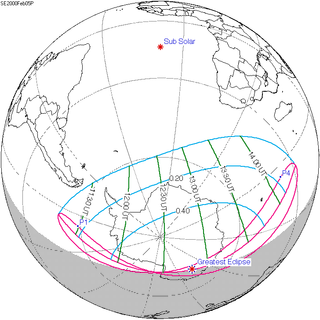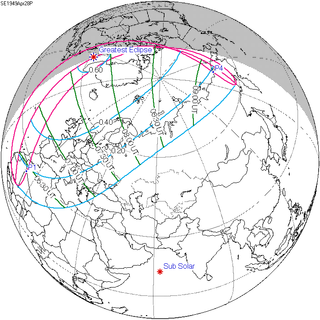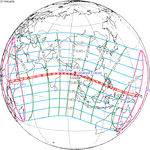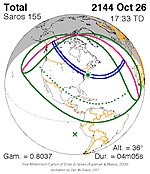
A partial solar eclipse occurred at the Moon’s descending node of orbit on Saturday, February 5, 2000, with a magnitude of 0.5795. A solar eclipse occurs when the Moon passes between Earth and the Sun, thereby totally or partly obscuring the image of the Sun for a viewer on Earth. A partial solar eclipse occurs in the polar regions of the Earth when the center of the Moon's shadow misses the Earth.

A partial solar eclipse occurred at the Moon’s ascending node of orbit on Saturday, July 1, 2000, with a magnitude of 0.4768. A solar eclipse occurs when the Moon passes between Earth and the Sun, thereby totally or partly obscuring the image of the Sun for a viewer on Earth. A partial solar eclipse occurs in the polar regions of the Earth when the center of the Moon's shadow misses the Earth.

A partial solar eclipse occurred at the Moon's descending node of orbit between Wednesday, April 17 and Thursday, April 18, 1996, with a magnitude of 0.8799. A solar eclipse occurs when the Moon passes between Earth and the Sun, thereby totally or partly obscuring the image of the Sun for a viewer on Earth. A partial solar eclipse occurs in the polar regions of the Earth when the center of the Moon's shadow misses the Earth.

A partial solar eclipse will occur at the Moon's descending node of orbit on Wednesday, February 27, 2036, with a magnitude of 0.6286. A solar eclipse occurs when the Moon passes between Earth and the Sun, thereby totally or partly obscuring the image of the Sun for a viewer on Earth. A partial solar eclipse occurs in the polar regions of the Earth when the center of the Moon's shadow misses the Earth.

A partial solar eclipse occurred at the Moon's descending node of orbit on Thursday, August 31, 1989, with a magnitude of 0.6344. A solar eclipse occurs when the Moon passes between Earth and the Sun, thereby totally or partly obscuring the image of the Sun for a viewer on Earth. A partial solar eclipse occurs in the polar regions of the Earth when the center of the Moon's shadow misses the Earth.

A partial solar eclipse occurred at the Moon's ascending node of orbit on Monday, June 21, 1982, with a magnitude of 0.6168. A solar eclipse occurs when the Moon passes between Earth and the Sun, thereby totally or partly obscuring the image of the Sun for a viewer on Earth. A partial solar eclipse occurs in the polar regions of the Earth when the center of the Moon's shadow misses the Earth.

A partial solar eclipse occurred at the Moon's descending node of orbit on Monday, January 25, 1982, with a magnitude of 0.5663. A solar eclipse occurs when the Moon passes between Earth and the Sun, thereby totally or partly obscuring the image of the Sun for a viewer on Earth. A partial solar eclipse occurs in the polar regions of the Earth when the center of the Moon's shadow misses the Earth.

A partial solar eclipse occurred at the Moon's ascending node of orbit on Monday, October 2, 1978, with a magnitude of 0.6905. A solar eclipse occurs when the Moon passes between Earth and the Sun, thereby totally or partly obscuring the image of the Sun for a viewer on Earth. A partial solar eclipse occurs in the polar regions of the Earth when the center of the Moon's shadow misses the Earth.

A partial solar eclipse occurred at the Moon's descending node of orbit on Friday, April 7, 1978, with a magnitude of 0.7883. A solar eclipse occurs when the Moon passes between Earth and the Sun, thereby totally or partly obscuring the image of the Sun for a viewer on Earth. A partial solar eclipse occurs in the polar regions of the Earth when the center of the Moon's shadow misses the Earth.

A partial solar eclipse occurred at the Moon's ascending node of orbit on Friday, December 13, 1974, with a magnitude of 0.8266. A solar eclipse occurs when the Moon passes between Earth and the Sun, thereby totally or partly obscuring the image of the Sun for a viewer on Earth. A partial solar eclipse occurs in the polar regions of the Earth when the center of the Moon's shadow misses the Earth.

A partial solar eclipse occurred at the Moon's descending node of orbit on Thursday, July 22, 1971, with a magnitude of 0.0689. A solar eclipse occurs when the Moon passes between Earth and the Sun, thereby totally or partly obscuring the image of the Sun for a viewer on Earth. A partial solar eclipse occurs in the polar regions of the Earth when the center of the Moon's shadow misses the Earth.

A partial solar eclipse occurred at the Moon's ascending node of orbit on Tuesday, May 9, 1967, with a magnitude of 0.7201. A solar eclipse occurs when the Moon passes between Earth and the Sun, thereby totally or partly obscuring the image of the Sun for a viewer on Earth. A partial solar eclipse occurs in the polar regions of the Earth when the center of the Moon's shadow misses the Earth.

A partial solar eclipse occurred at the Moon's descending node of orbit on Sunday, March 27, 1960, with a magnitude of 0.7058. A solar eclipse occurs when the Moon passes between Earth and the Sun, thereby totally or partly obscuring the image of the Sun for a viewer on Earth. A partial solar eclipse occurs in the polar regions of the Earth when the center of the Moon's shadow misses the Earth.

A partial solar eclipse occurred at the Moon's descending node of orbit on Saturday, July 11, 1953, with a magnitude of 0.2015. A solar eclipse occurs when the Moon passes between Earth and the Sun, thereby totally or partly obscuring the image of the Sun for a viewer on Earth. A partial solar eclipse occurs in the polar regions of the Earth when the center of the Moon's shadow misses the Earth.

A partial solar eclipse occurred at the Moon's descending node of orbit on Sunday, August 9, 1953, with a magnitude of 0.3729. A solar eclipse occurs when the Moon passes between Earth and the Sun, thereby totally or partly obscuring the image of the Sun for a viewer on Earth. A partial solar eclipse occurs in the polar regions of the Earth when the center of the Moon's shadow misses the Earth.

A partial solar eclipse will occur at the Moon's ascending node of orbit on Monday, November 14, 2050, with a magnitude of 0.8874. A solar eclipse occurs when the Moon passes between Earth and the Sun, thereby totally or partly obscuring the image of the Sun for a viewer on Earth. A partial solar eclipse occurs in the polar regions of the Earth when the center of the Moon's shadow misses the Earth.

A partial solar eclipse will occur at the Moon's ascending node of orbit between Thursday, June 20 and Friday, June 21, 2058, with a magnitude of 0.126. A solar eclipse occurs when the Moon passes between Earth and the Sun, thereby totally or partly obscuring the image of the Sun for a viewer on Earth. A partial solar eclipse occurs in the polar regions of the Earth when the center of the Moon's shadow misses the Earth.

A partial solar eclipse will occur at the Moon's descending node of orbit on Saturday, November 16, 2058, with a magnitude of 0.7644. A solar eclipse occurs when the Moon passes between Earth and the Sun, thereby totally or partly obscuring the image of the Sun for a viewer on Earth. A partial solar eclipse occurs in the polar regions of the Earth when the center of the Moon's shadow misses the Earth.

A partial solar eclipse occurred at the Moon's ascending node of orbit on Thursday, April 28, 1949, with a magnitude of 0.6092. A solar eclipse occurs when the Moon passes between Earth and the Sun, thereby totally or partly obscuring the image of the Sun for a viewer on Earth. A partial solar eclipse occurs in the polar regions of the Earth when the center of the Moon's shadow misses the Earth.

A partial solar eclipse occurred at the Moon's ascending node of orbit on Thursday, September 10, 1942, with a magnitude of 0.523. A solar eclipse occurs when the Moon passes between Earth and the Sun, thereby totally or partly obscuring the image of the Sun for a viewer on Earth. A partial solar eclipse occurs in the polar regions of the Earth when the center of the Moon's shadow misses the Earth.
















































































































